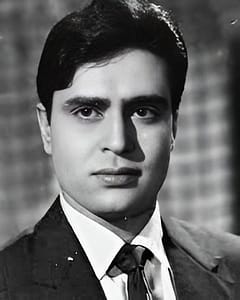
Rajendra Kumar Evergreen Jubilee Star Introduction.
Rajendra Kumar Tuli, one of the most prominent and bankable stars of Hindi cinema during the 1950s to the 1970s, earned the moniker “Jubilee Kumar” due to his unparalleled record of consecutive silver and golden jubilee hits. Known for his emotive acting, genteel charm, and romantic roles, he was one of the pillars of classic Bollywood during its golden age. With a career spanning over four decades and a legacy marked by memorable films, Rajendra Kumar became a household name whose contribution to Indian cinema remains unmatched.
Early Life and Background
Rajendra Kumar was born on 20 July 1929, in Sialkot, then a part of British India (now in Pakistan), into a Punjabi Hindu family. His full name was Rajendra Kumar Tuli. His father, Lala Jawala Prasad Tuli, was a well-established businessman. The family was leading a comfortable life until the Partition of India in 1947, which uprooted millions, including the Tuli family, who migrated to Bombay (now Mumbai).
Post-Partition, the Tulis faced hardships, but Rajendra Kumar was determined to make something of his life. With an interest in films and the backing of his education, he started looking for opportunities in the burgeoning Bombay film industry.
Early Struggles in the Film Industry
Like many aspiring actors, Rajendra Kumar’s entry into Bollywood was not easy. He began his career not as an actor but as an assistant director, working under H.S. Rawail in the film Patanga (1949). His early days behind the camera gave him valuable insight into the workings of the film industry.
Eventually, he began appearing in small roles. One of his first screen appearances was in the film “Jogan” (1950), where he played a minor part alongside legendary actors Nargis and Dilip Kumar. Slowly but steadily, he began to get noticed.
Rise to Stardom
Rajendra Kumar’s big breakthrough came with “Vachan” (1955), which was a commercial success and gave him the visibility he needed. However, it was “Mother India” (1957) — India’s first film to be nominated for an Academy Award — that solidified his position. In this film, he played Nargis’s son, even though she had earlier played his romantic interest in Jogan. His powerful performance alongside Nargis and Sunil Dutt was widely praised.
Following this, Rajendra Kumar’s career skyrocketed. From the late 1950s through the 1960s, he delivered a series of box office hits. He became the quintessential romantic hero, known for his roles in family dramas and love stories.
The Era of Silver and Golden Jubilees
Rajendra Kumar’s nickname “Jubilee Kumar” stemmed from the fact that many of his films ran in theaters for over 25 weeks (silver jubilee) and some even 50 weeks (golden jubilee). Between 1960 and 1969, nearly all his films were massive hits.
Some of his iconic films from this golden period include:
- “Ghar Sansar” (1958)
- “Goonj Uthi Shehnai” (1959)
- “Dhool Ka Phool” (1959)
- “Kanoon” (1960)
- “Gharana” (1961)
- “Dil Ek Mandir” (1963)
- “Zindagi” (1964)
- “Arzoo” (1965)
- “Suraj” (1966)
- “Jhuk Gaya Aasman” (1968)
- “Saathi” (1968)
- “Talash” (1969)
These films established him as a reliable actor with a strong emotional connect with the audience. He had a remarkable ability to portray the ideal Indian man — dutiful son, loving husband, and loyal friend — with natural ease.
Acting Style and On-Screen Persona
Rajendra Kumar was not known for flamboyant or intense acting but for his subtlety and sincerity. His calm demeanor and soft-spoken delivery created an enduring appeal, especially among family audiences. He exuded a warmth on screen that made him believable in roles of a doctor, husband, or friend.
Music played a vital role in his career. Many of his films featured memorable songs sung by legends like Mohammed Rafi, Lata Mangeshkar, and Mukesh, with composers like Shankar-Jaikishan and Ravi contributing to his films’ success.
Personal Life
Rajendra Kumar was married to Shila Tuli, and the couple had three children, including Kumar Gaurav, who also went on to become an actor. Rajendra Kumar was a family-oriented person, and despite his stardom, he maintained a low-profile personal life, rarely being involved in controversies.
He was known to be close friends with Sunil Dutt, and the bond between their families continued for decades. Rajendra Kumar even helped launch his son Kumar Gaurav’s career with the film “Love Story” (1981), which he produced.
Transition to Character Roles
By the early 1970s, the face of Indian cinema started changing. A new wave of actors like Rajesh Khanna and Amitabh Bachchan took center stage, representing a younger, more dynamic style. Rajendra Kumar, whose romantic hero days were waning, gracefully transitioned into character and supporting roles.
He appeared in supporting but important roles in films like:
- “Saajan Bina Suhagan” (1978)
- “Love Story” (1981) – where he played the father of Kumar Gaurav’s character
- “Naam” (1986) – with Sanjay Dutt and Kumar Gaurav
- “Phool” (1993)
These films showed his versatility and willingness to evolve as an actor.
Contribution as a Producer
In the 1980s, Rajendra Kumar also made a mark as a producer. His banner “Shankar Movies” (named after his father) produced several films. The biggest among these was “Love Story”, which became a huge commercial hit and established his son as a teenage icon.
Though Kumar Gaurav could not sustain long-term stardom, Rajendra Kumar always supported him and tried to revive his career through various projects.
Awards and Honors
Rajendra Kumar’s contribution to Indian cinema has been widely recognized:
- In 1969, he was awarded the Padma Shri, one of India’s highest civilian honors.
- He received several Filmfare nominations, particularly for Dil Ek Mandir and Arzoo.
- Over time, he was also honored at various film festivals and lifetime achievement ceremonies for his lasting legacy.
Later Years and Health Issues
In his later years, Rajendra Kumar stayed away from the limelight but remained involved in the film industry behind the scenes. Unfortunately, his health began to deteriorate in the late 1990s. He was diagnosed with cancer, which he battled quietly and with dignity.
Despite his illness, he continued to participate in family and film-related events, always remembered with great respect and affection by the industry.
Death and Legacy
Rajendra Kumar passed away on 12 July 1999, just days before his 70th birthday, in Mumbai. His death marked the end of an era — that of the clean, romantic, emotional hero who symbolized Indian family values and virtues on screen.
His funeral was attended by a large number of film personalities, with Sunil Dutt, Amitabh Bachchan, and Dharmendra among those paying their last respects.
Cultural Impact and Legacy
Rajendra Kumar’s legacy in Indian cinema is profound:
- Box Office Icon: His record of consecutive jubilee hits made him a phenomenon in Bollywood economics. Distributors often banked on his name alone.
- Family Man Image: At a time when machismo or tragedy dominated male roles, Rajendra Kumar carved a niche as the sensitive and ideal Indian man.
- Musical Milestones: His films left behind a rich library of classic songs that remain timeless.
- Mentorship: He played a vital role in supporting younger actors and was known for mentoring talents, including his son.
- Respected Veteran: Even after his peak, he was respected by younger actors and filmmakers for his humility and contributions.
Conclusion
Rajendra Kumar may not have had the flamboyance of Shammi Kapoor or the intensity of Dilip Kumar, but his quiet strength, dedication to craft, and connection with the masses made him a legend of Hindi cinema. His films were not just box office successes but stories that reflected the values, hopes, and emotions of an entire generation.
From “Mother India” to “Love Story,” from romantic hero to doting father, Rajendra Kumar’s journey through Indian cinema was a testament to perseverance, talent, and grace. Even decades after his death, the name “Jubilee Kumar” continues to evoke nostalgia, admiration, and reverence — a true icon of Indian film history.




One thought on “Rajendra Kumar: The Evergreen Jubilee Star of Indian Cinema.”